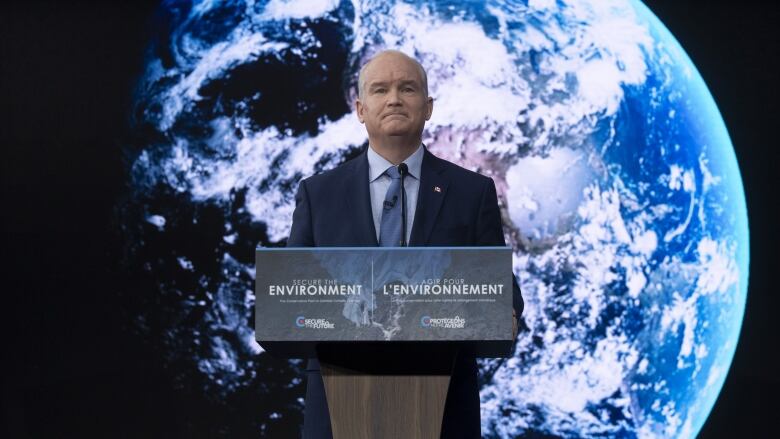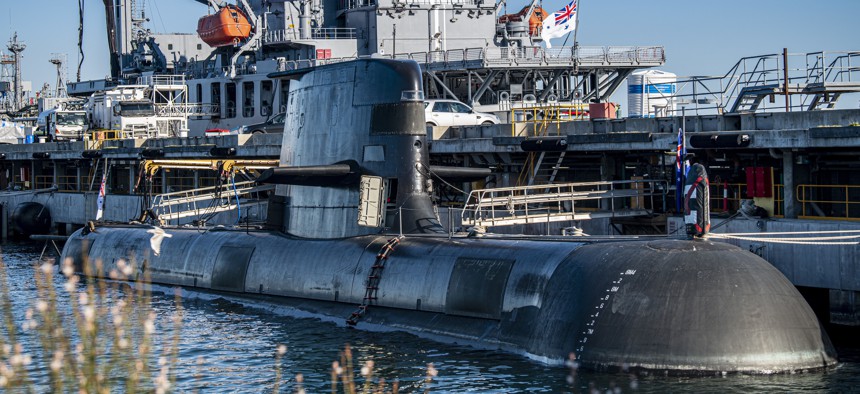Moving from fringe to 4th place, PPC complicates the Conservatives' path to power
The rise of Maxime Bernier's party could cost the Conservatives some seats, polls suggest

At a recent campaign event, Conservative Leader Erin O'Toole couldn't quite bring himself to say the name of the man who could end up thwarting his shot at power.
People's Party of Canada (PPC) Leader Maxime Bernier has gone from leading a small fringe group with tepid support to heading up a right-wing party that, according to the CBC Poll Tracker, could have the fourth-highest share of the vote on Sept. 20.
After the last election campaign, a CBC News analysis showed that — even with its rather dismal level of support — the PPC likely cost the Conservatives seven seats in the House of Commons by splitting the vote (six seats went to the Liberals, one to the NDP). With polls suggesting PPC support is now well above the 1.6 per cent of the vote it got last time, its impact could be even greater in 2021.
When asked by CBC News recently what he plans to do to blunt Bernier's momentum and prevent a vote-splitting scenario that could hand Liberal Leader Justin Trudeau another term, O'Toole didn't say much — and never mentioned Bernier by name.
O'Toole was asked three questions about the former Conservative cabinet minister-turned PPC leader at a Sunday press conference and ducked every one of them.
"I remind Canadians, if you're tired of a Liberal government that's constantly in scandal, corrupt at its core with Mr. Trudeau's constant ethics investigations, there's one team and one leader that can replace him — Canada's Conservatives," O'Toole finally said when pressed.
His party's campaign material insists Canadians only have four choices in this election. "If you don't care about creating Canadian jobs and standing up to the Chinese Communist Party, you have three parties to choose from. If you do, you only have one choice – Canada's Conservatives," reads a recent press release.
While polls suggest some PPC support is coming from first-time or infrequent voters, there's no question the PPC is drawing at least some support from former Conservative voters.
"The Conservative party is no longer a conservative party," Craig Mostat, an-ex Conservative supporter of the PPC from Edmonton, told CBC News.
"They are bending over backwards to do everything the Liberals are doing," he said, referring to the party's more moderate brand of conservatism under O'Toole.
An outgoing Conservative MP, David Yurdiga, is backing Bernier and Shawn McDonald, the local PPC candidate in his Fort McMurray, Alta. riding.
"We're the true conservatives. We're bringing people home," McDonald told the conservative online media outlet True North.
Some pollsters — notably those using more anonymous collection methods, like interactive voice response (IVR) — show higher levels of PPC support than those firms using live telephone agents or an online forum to survey the public on their voting choices.
While the country's major polling firms can't agree on just how much support the PPC enjoys, it's clear that the party is much more of a force now than it was in the 2019 campaign
"There's definitely a lot more people jumping on the PPC train even compared to two months ago. It's definitely getting bigger," said Rodolpho Menjivar, an infrequent Alberta voter who has voted Liberal in the past but plans to pick the PPC this time.
"People are looking for another option because they don't like what everyone else is doing."
Philippe Fournier, a polls analyst with 338Canada, said the PPC's strength could spell trouble for the Conservatives in close races in Prairie cities like Calgary, Edmonton and Winnipeg. In 2019, the party only narrowly won seats like Manitoba's Charleswood—St. James—Assiniboia—Headingley and Alberta's Edmonton Centre over the Liberals.
"The PPC could get more votes than the Bloc Quebecois in this election, which was unfathomable only one year ago," Fournier said. "We can say with confidence that many of their supporters used to vote Conservative."
Failure to launch — then a sudden resurgence
Bernier's dramatic break from the Conservative party in 2018 was a troubling development for some Conservative operatives who feared a fractured right-centre vote would guarantee Liberal victories for years to come.
At the time, however, most Conservative insiders — especially those who knew him from his time as a Harper-era cabinet minister — were dismissive of Bernier's potential political impact.
They feared a splintered vote but they didn't think Bernier was well-equipped to get a new party off the ground and compete meaningfully in enough ridings to make much of a difference.
The PPC's poor showing in 2019 — Bernier lost the Beauce seat he'd held for years — bolstered the naysayers.
But the COVID-19 pandemic has led to a political realignment, breathing new life into a party that looked all but dead.
Public health measures like lockdowns slowed the spread of the virus — and likely saved lives — but they also prompted anger and frustration among some Canadians who saw their livelihoods destroyed as economic and social life ground to a halt.
The PPC becomes the no-lockdowns party
The federal Conservative Party and some of its provincial counterparts, like the Ontario Progressive Conservative Party, were generally deferential to public health officials who called for restrictions — a sensible position during a pandemic but one that also generated backlash from people who bristle at limits on their freedoms.
The PPC welcomed those voters with open arms. A party promising a radically smaller government with fewer regulations was suddenly embraced by people who saw government as an oppressive force.
Bernier, a libertarian who has long railed against government overreach, became a champion of the "no more lockdowns" crowd, routinely appearing at well-attended protests against these restrictions.

Liberal Leader Justin Trudeau's push for a vaccine mandate for federal public servants and the travelling public has also given Bernier another cause as he warns of what he calls Canada's descent into "tyranny."
"We are the only national political party against vaccine passports. We believe in freedom of choice — everyone must be able to decide for themselves," Bernier said a recent rally.
O'Toole is opposed to Trudeau's proposed vaccine mandate but has said he'd let provinces introduce their own vaccine passport programs.
Bernier's pitch to voters also includes a plan to "defund" the CBC, balance the budget quickly, cut all foreign aid, "say no to the UN" — a body he calls "a dysfunctional organization" — and pull out of the Paris climate accord.
"More and more people are coming on our side. You can count on us," Bernier said.
But it's Bernier's strident opposition to the idea of vaccine passports — credentials people vaccinated against COVID-19 can show to businesses to make everyday activities safer — that attracted Menjivar.
"The particular thing I like about them is that they're a no to vaccine passports and mask mandates. I don't believe in mandatory stuff forced on people and not being able to go places if I don't have a vaccine," he said.
"People just want to be left alone and not be called the bad guy for not getting their vaccine. We just want to live and be able to do everything we did two years ago."
Fournier said the polls suggest it's Bernier's anti-vaccination passport rhetoric driving the party's rise.
"We know from polls before the election that anti-vaxxers were about eight to 10 per cent of the Canadian population," Fournier said. "He is taking his message to new heights to appeal to these people.
"And if he goes from 1.6 per cent in 2019 to seven or eight or more per cent in this election, it would be an incredible achievement."








/https://www.thestar.com/content/dam/thestar/news/canada/2021/09/16/how-we-got-here-a-timeline-of-albertas-response-to-the-covid-19-pandemic/hinshaw.jpg)
/https://www.thestar.com/content/dam/thestar/uploads/2021/09/16/hospitalizations-0.png)
/https://www.thestar.com/content/dam/thestar/news/canada/2021/09/16/how-we-got-here-a-timeline-of-albertas-response-to-the-covid-19-pandemic/stampede3.jpg)
/https://www.thestar.com/content/dam/thestar/news/canada/2021/09/16/how-we-got-here-a-timeline-of-albertas-response-to-the-covid-19-pandemic/protest.jpg)
/https://www.thestar.com/content/dam/thestar/uploads/2021/09/16/canadamap-0.png)


